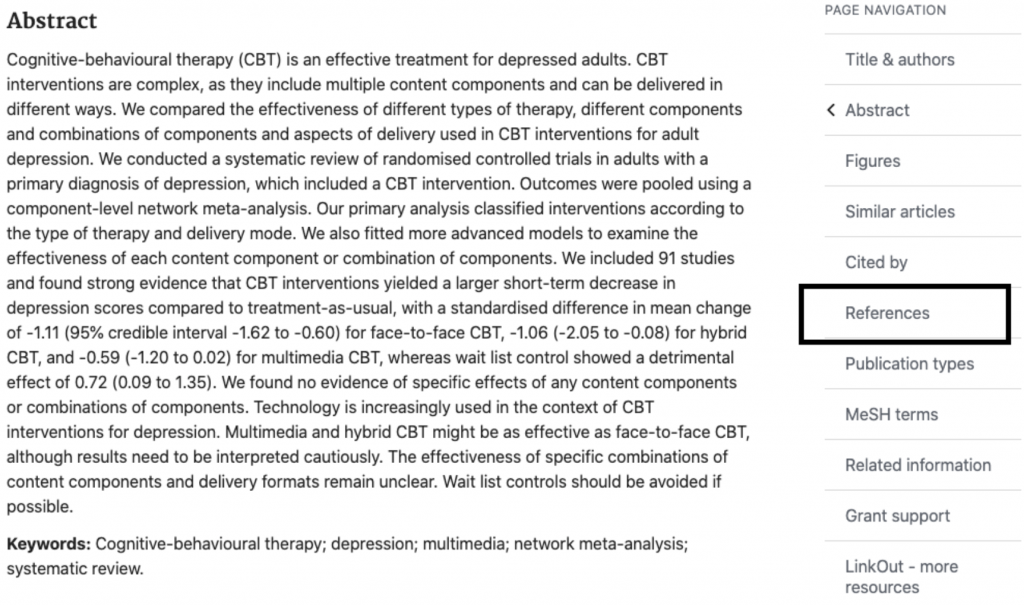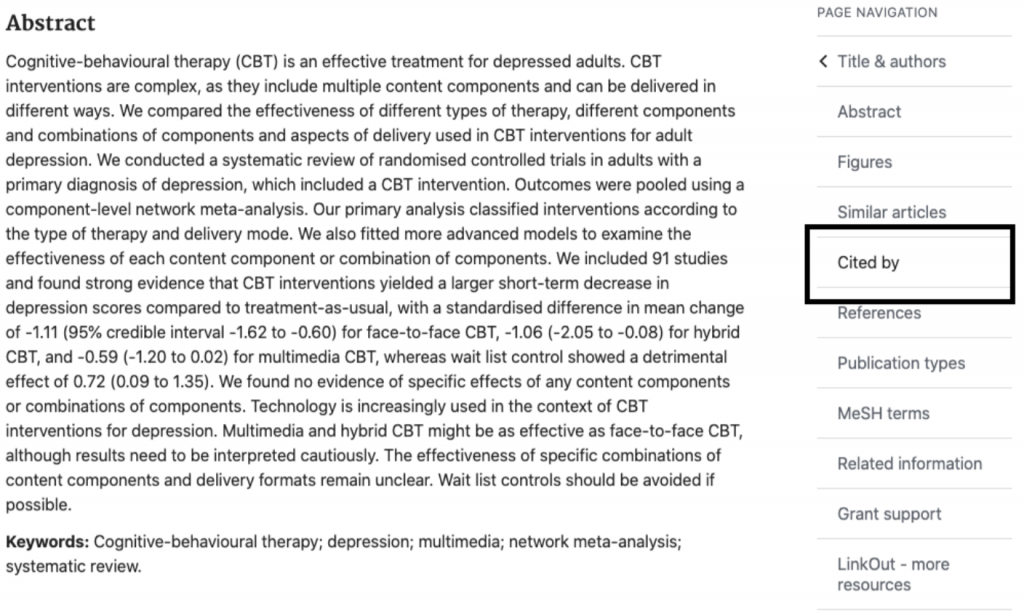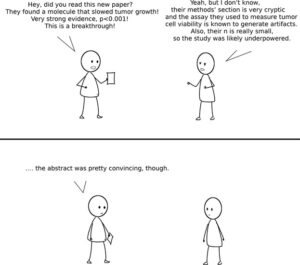Module 2: Formulating a Research Question and Searching for Sources
Using Citations to Find More Sources
Besides your standard search there are additional options to identify relevant sources including searching key journals in your field, and tracking the work of relevant authors.
Another method used by researchers is to consult the citations within an article. By consulting the citations you can find relevant titles that you might have missed in your search. The advantage of this method is that you can find sources about a subject quickly and relatively easily. The disadvantage of this method is that you are searching backward, or retrospectively, so each source you find will be older than the previous one.
This is why you need to use a forward citation searching method in combination with your backward citation search. In the forward searching method, researchers use tools within databases like Google Scholar and Web of Science to see who has recently cited your source. This way you can find new and relevant sources.
Method 1: Backward Searching
In this method, review the references used in key articles. For example, search through the article for the “References” section as in Figure 2.9 below.

Method 2: Forward Searching
In this method, see what articles have cited your key articles. For example, search through the “Cited by” section of the article as in Figure 2.10 below.

Many databases will include live links to an article’s references, as well as live links to other articles that have cited that article. The following video demonstrates how to do citation searching in Google Scholar:
CSUDH Library. Citation Tracking. Licenced under Creative Commons CC BY 4.0. Closed Captioned
Citation Mapping Tools
If you’ve ever clicked on a link titled something like “suggested for you” or “you may also like” on your favourite online store, you were taking advantage of an algorithm that uses your interests to identify related items. Algorithms search for to collate similar items. This is similar to clicking a hashtag on social media sites like Instagram.
Citation mapping tools are an academic version of this process. Not only do these tools look for items that have similar metadata, they also leverage the world of bibliometric data to create a visual representation of the world that surrounds a single article. These tools require you to enter a citation (often referred to as a “seed paper”) you are interested in further exploring. The results will vary depending on the tool you select, but in general, you will be led to further works related to the seed paper either by the similarity in their bibliographies or adjacency to similarly cited works.
When should you use a citation mapping tool?
It may be very tempting to want to rely on a tool that works quickly, and uncovers potentially new articles. However, be cautious when deciding how to make use of a citation mapping tool. The majority of these tools are using algorithms that are not transparent in their composition and operation. This is problematic if you are engaged in a systematic review where replicability of the search is essential to the methodology. Moreover, over-reliance on AI tools when engaging in an academic exercise is a slippery slope. One must always keep in mind that the entire purpose of a literature review is to gain a deeper understanding of the existing literature and thought in your field. AI tools can be helpful to enhance productivity; they are not a replacement for critical or in-depth thinking about information.
Secondly, there are existing tools and methods that are thoroughly documented and have been used for decades. The novelty of an AI tool should not replace the use of existing approaches to forward and backward citation searching (also known as citation chasing) that can be replicated, and are widely acknowledged as standard in evidence synthesis. The old adage of “if it ain’t broke, don’t fix it” is applicable here. Using traditional citation indexes such as Scopus or Web of Science should be sufficient for reliable citation chasing.
Finally, it can be very tempting to use a tool that you feel will save you time. However, research should not feel like a race, and skimming your way through a literature review is a mistake. The devil, they say, is in the details. Poor reading habits such as over-reliance on abstracts or machine-generated summaries can lead to misreadings of studies in your review. Using an abstract or summary to determine relevance is appropriate; relying solely on them for interpretation of a studies’ purpose, methods, findings and conclusions is a recipe for misinterpretation. This can snowball and lead to embarrassing errors, and worse, charges of dishonesty.

If, however, you are not engaged in a proper systematic review or meta-synthesis, and instead are working in the area of qualitative evidence synthesis (QES), or are engaged in a wide-ranging scoping search, you may want to consider using a citation mapping tool to expand the pool of sources as a supplementary search method. According to the Cochrane Handbook for Systematic Reviews of Interventions, “poor indexing of qualitative studies makes citation searching (forward and backward) and the Related Articles features of electronic databases particularly useful”(Harris et al., 2018). Furthermore, methodological studies have found that supplementary search methods (i.e. those methods undertaken outside of database searching), including citation chasing, is beneficial in identifying unique studies, especially in the social sciences (Cooper et al., 2017).
In short, using a citation mapping tool for discovery when supplementary search strategies are called for can be immensely useful. As a tool to enhance productivity, however, it should be given careful thought and not be solely relied upon, particularly given the mysterious nature of its functionality.
How to select a citation mapping tool?
It is challenging to recommend any one tool. Much will depend on your discipline, the goal of your research, or even just personal preference. Many tools are open access, others require users to create a user account, and still others are subscription based. Aaron Tay, a librarian from Singapore Management University, maintains a comprehensive list of currently available citation mapping tools on his blog. The best way to determine which tool is right for you is to go ahead and experiment with them! Select an article with which you are very familiar and use it as your “seed paper” in the tools you are keen to try.
Cooper, C., Booth, A., Britten, N., & Garside, R. (2017). A comparison of results of empirical studies of supplementary search techniques and recommendations in review methodology handbooks: A methodological review. Systematic Reviews, 6(1), 234.
Harris, J. L., Booth, A., Cargo, M., Hannes, K., Harden, A., Flemming, K., Garside, R., Pantoja, T., Thomas, J., & Noyes, J. (2018). Cochrane Qualitative and Implementation Methods Group guidance series—paper 2: Methods for question formulation, searching, and protocol development for qualitative evidence synthesis. Journal of Clinical Epidemiology, 97, 39–48.
A set of data that describes and gives information about other data

